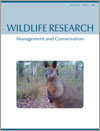Context. Selective logging of native forests creates a mosaic of disturbance histories; however, little is known about how different taxa respond to such a mosaic.
Aims. We followed adaptive-management principles to test logging and burning impacts on eastern pygmy possums, Cercartetus nanus (Geoffroy and Desmarest, 1817), by undertaking a large-scale field experiment that coincided with harvesting. We predicted that home range would increase after logging because of a reduction in resources (food and/or dens) and because hollows suitable for denning would decrease, resulting in greater use of unlogged patches and alternate dens.
Methods. We radio-tracked C. nanus in a before-and-after logging experiment to investigate home range, habitat selection and den use. We tracked 50 possums, some individuals for a maximum of 8 months, within control, recently logged and regrowth (5 years since logging) sites.
Key results. Home ranges were variable (0.04–19.5 ha), with males having significantly larger home ranges. We were unable to detect a difference in home-range size between controls and the first year after logging and burning, or regrowth 5 years after logging. Home ranges comprised a mosaic of disturbed and undisturbed areas, and possums did not avoid logged habitat in their home ranges, indicating that logging did not significantly influence habitat selection. We suggest that possums were not sensitive to selective logging and burning because nectar-producing plants are adapted to fire disturbance and because a variety of den sites were used, most commonly in tree hollows and fallen logs, which were commonly left as logging residue. Indeed, possums frequently denned in logged patches, both recently after logging (63% of dens) and in regrowth 5 years after logging (76% of dens). Counts of fallen hollow logs at each site indicated that their density was not reduced by logging, with regrowth sites having the greatest abundance of logs (260 ha–1).
Conclusions. The mosaic of disturbance created by selective logging operations did not negatively affect home range or den selection of C. nanus.
Implications. Ecologically sustainable logging practices that include a range of mitigation measures to protect biodiversity can be compatible with the management of threatened species. Assessment of the effectiveness of these methods often will rely on scientific research.





